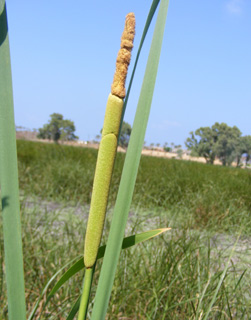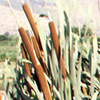Typha latifolia (Common Bulrush, Common Cattail) is a very rare species of Typha. It is very similar to Typha domingensis (Lesser Bulrush, Narrow Leaf Cattail), but its leaves are broader, 2 cm or more. Common Bulrush is an erect and tall riparian perennial plant. It develops a branched stem in the form of a crawling rhizome inside the soil, which contains intracellular spaces that store air, which assist in its respiration in the oxygen-poor environment of the water. Leaves extend upwards from the rhizome nodes and roots extend downwards. This enables the plant vigorous vegetative reproduction. Common Bulrush has no above-ground stems, except for the flower spike. The leaves grow straight out of the soil, from the rhizome, and are straight, erect and very long, reaching up to 2 m. They are 2 cm or more wide. What is their secret? How can such a long and thin leaf stand erect? The leaf is indeed narrow, but not flat. Rather, it is thick (4 mm). If we cut the leaf in cross-section, we will discover a wonderful system of box-shaped septa, separated by air spaces. The septa afford the leaf mechanical strength, and the air spaces afford passage for oxygen-rich air from the leaves to the rhizome and roots which are immersed in the mud. The leaf twists somewhat around its length, which also adds to its stability.
Common Bulrush blooms in the summer. It differs from Lesser Bulrush also in its inflorescence, which has no space between the male and female part. The flowers are darker towards the end of the bloom.
Common Bulrush grows mainly in the Coastal Plain, but also in the Hula Valley and the Kinneret Valley. It has a wide worldwide distribution.
The genus contains 10 species. In Israel there are 4 species, 3 of which are very rare. The genus is isolated, the only one in its family, the Typhaceae family, which is included in the order Arecales.
Written by Mike Livne




